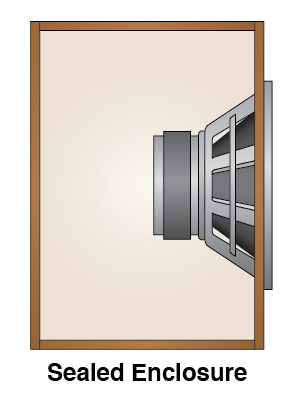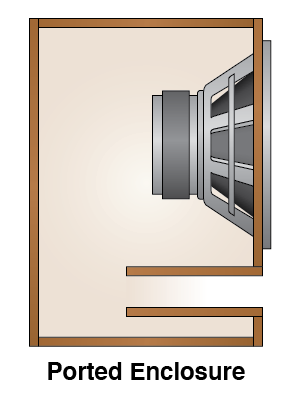What Does a Subwoofer Enclosure do?
A subwoofer enclosure is a box that contains a sub speaker. There are different types of sub boxes, but they all serve the same function. A sub box builds up the air pressure that the subwoofer emits, which arrives at our ears as increased bass.
It’s important to add an enclosure so you can appreciate the full sound of the bass in your music. Without an enclosure, the sound-waves coming from the speaker’s backside cancel-out low frequencies coming from the front, making the sub sound weak or even non-existent.
What you might not know is there are two different kinds of bass schools of thought: “tight” and “boomy.” Some people want a tight bass sound. Others prefer a powerful broad booming bass sound. The type of bass sound you want will determine the subwoofer and the enclosure type you select.
See our Woofer BoxAdvisor for recommended enclosure size and type for a Rockford Fosgate subwoofer.
Types of Subwoofer Enclosures
There are three major categories of enclosures: sealed, ported, and bandpass. Each emits a different type of sound; one isn’t better than the other, and your selection is based entirely on your listening preference and the amount of space that you have in your vehicle for the enclosure. For the purposes of this article, we will focus on the two most often used enclosures: sealed and ported. Bandpass enclosures are typically very large and therefore not often used.
What is a Sealed Subwoofer Enclosure?

Music types that work well with a sealed sub are jazz, some pop music, and classical, though many rock lovers who want a tighter low-end opt for sealed enclosures, too.
What is a Ported Subwoofer Enclosure?
A ported enclosure is a box that has a specific port or hole cut into it, typically mounted onto the front or top of the box to provide loud, boomy bass. This allows two mechanisms to create the bass sound, the

speaker itself, and the air coming off the backside of the speaker through the port. It’s larger than a sealed box and has more boomy bass, which means it’s louder and less crisp sounding as the sound echoes in the chamber. If you are considering a ported enclosure, you’ll want to measure to make sure you have enough space in your trunk or wherever you plan on placing the sub.
Tuning the Port
Tuning the port is vital to maximizing the output capability of the subwoofer. Though you’ll see different porthole shapes and sizes, tuning the port is a science, not a guessing game. You can’t just cut a random-sized hole in an enclosure and expect good results. Proper tuning uses mathematical calculations taking into account the speaker size, box size, and length of the port. If a port is incorrectly tuned, it can hamper the performance of the sub. It may ultimately cause your sub to fail. Rockford Fosgate’s ported loaded subwoofer enclosures come completely optimized and tuned for the subwoofers that are installed in them.
Since subwoofers installed in ported enclosures have a less gentle low-end roll-off than sealed enclosures, ported subs tend to reproduce the lower frequencies found most often in rap music more loudly.
In audio competitions, you’ll typically find competitors using ported enclosures because they produce a higher sound pressure level.
Overall, this is an excellent choice of enclosure if you’re looking for that big boomy sound for rap, rock, or heavy metal.
What is a Bandpass Subwoofer Enclosure?
 A bandpass enclosure is one in which the speaker lies entirely within the cabinet or box. The woofer does not play directly into the listening area. If you look at a bandpass sub, you won’t see the speaker visible. Instead, the speaker cone plays into a chamber, and then all of the sound is produced through a port or multiple ports.
A bandpass enclosure is one in which the speaker lies entirely within the cabinet or box. The woofer does not play directly into the listening area. If you look at a bandpass sub, you won’t see the speaker visible. Instead, the speaker cone plays into a chamber, and then all of the sound is produced through a port or multiple ports.
This enclosure gives even more “boom” than ported enclosures. There are two kinds of bandpass subwoofers.
Single Ported Bandpass Enclosure
You’ll find both a sealed chamber and a ported chamber. The sound waves emanate from the ported side, making it even louder than a simple ported enclosure.
Dual Ported Bandpass Enclosures
A dual-ported bandpass filter has two ports, one on each side of the subwoofer.
Dual-port enclosures work best for those wanting the biggest boom possible. It delivers a lot of boom and less tone: many rap and reggae aficionados like bandpass enclosures for this reason.
The Cons of a Bandpass
Because it is wholly contained inside a box, the speaker in a bandpass box is pushing against higher air resistance both when it moves forward and backward. This puts a lot of stress on the speaker cone. Sometimes the cone may tear if the speaker is overpowered and pushed to its maximum SPL level. It’s vital that you use the proper wattage and carefully set amplifier gains to enhance the performance and life of your bandpass sub.
Also note, a bandpass box is typically large, so you need to make sure your car, truck, or SUV has room for it.
IMPORTANT: If constructed improperly, a bandpass enclosure will damage your subwoofer. For this unique application, we highly encourage you to contact Rockford technical support to talk about your installation before you begin.
What is a free-air subwoofer?
 An infinite baffle or free-air subwoofer system is a subwoofer that can be attached directly to your trunk, against a seat rear deck using high-density fiberboard in your car. It is used for cars that have little or no space in the trunk. The speaker does not have an enclosure or box. The trunk of your car becomes a “semi-sealed” enclosure. This fixes the sound cancellation problem that happens when your sub doesn’t have an enclosure around it.
An infinite baffle or free-air subwoofer system is a subwoofer that can be attached directly to your trunk, against a seat rear deck using high-density fiberboard in your car. It is used for cars that have little or no space in the trunk. The speaker does not have an enclosure or box. The trunk of your car becomes a “semi-sealed” enclosure. This fixes the sound cancellation problem that happens when your sub doesn’t have an enclosure around it.
This type of free-air system is definitely easier to install in your car, but you need a specific subwoofer designed for this type of system. You must make sure your trunk is sealed tightly for the sound to be effectively delivered. The power to your subwoofer will need to be much lower than it would for a subwoofer in an enclosure. This can save you money. A free-air sub will not have quite the level of performance as one of the three enclosure options mentioned earlier.
IMPORTANT: Because of the high potential of inadequate performance from a free air sub, we typically do not recommend them. If you decide to use this unique application you should contact Rockford technical support to talk about your installation.
Get the Best Subwoofer Enclosure for Your Needs
No matter what type of music you enjoy, a subwoofer adds a powerful impact to the sound.
Our Rockford Fosgate support team or a Rockford Fosgate authorized dealer will be glad to guide you in the selection of a sub enclosure that meets your exact needs.
You can also use Rockford Fosgate’s Box Wizard to see different subwoofer enclosures that may fit your vehicle.
See the next car subwoofer article: Are 2 Subs Better than 1?
FAQs
What is the purpose of a subwoofer enclosure?
A subwoofer enclosure traps and controls the air behind the speaker so low-frequency waves from the front and back don’t cancel each other. It boosts bass output and improves clarity.
What are the main types of subwoofer enclosures and how do they differ?
The main types are sealed, ported, and bandpass. A sealed enclosure gives tighter, more accurate bass; a ported enclosure adds louder, “boomier” sound; and a bandpass box encloses the speaker entirely and outputs sound through ports, offering maximum boom but with design trade-offs.
When should I choose a sealed enclosure versus a ported or bandpass design?
Choose a sealed box when you prefer tighter, more precise bass and have limited space. Choose a ported enclosure if you want louder output and more low-end boom. Use a bandpass design only if you need the highest SPL in a specific frequency band and have space and design expertise.
What is a free-air (infinite baffle) subwoofer setup, and when is it usable?
A free-air or infinite baffle setup places the subwoofer without a box, using the vehicle’s trunk or panels as the enclosure. It’s used when space is tight, but it requires a subwoofer designed for free-air use and a well-sealed trunk. Its performance is usually weaker compared to proper enclosures.
What are the risks of using a poorly designed bandpass enclosure?
A poorly constructed or incorrectly tuned bandpass enclosure can damage your subwoofer, especially due to high air pressure and driver stress. It can also restrict performance, mismatching frequency response or causing distortion.